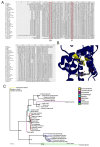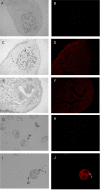Molecular characterization of Clonorchis sinensis secretory myoglobin: delineating its role in anti-oxidative survival
- PMID: 24885788
- PMCID: PMC4057808
- DOI: 10.1186/1756-3305-7-250
Molecular characterization of Clonorchis sinensis secretory myoglobin: delineating its role in anti-oxidative survival
Abstract
Background: Clonorchiasis is a globally important, neglected food-borne disease caused by Clonorchis sinensis (C. sinensis), and it is highly related to cholangiocarcinoma and hepatocellular carcinoma. Increased molecular evidence has strongly suggested that the adult worm of C. sinensis continuously releases excretory-secretory proteins (ESPs), which play important roles in the parasite-host interactions, to establish successful infection and ensure its own survival. Myoglobin, a hemoprotein, is present in high concentrations in trematodes and ESPs. To further understand the biological function of CsMb and its putative roles in the interactions of C. sinensis with its host, we explored the molecular characterization of CsMb in this paper.
Methods: We expressed CsMb and its mutants in E. coli BL21 and identified its molecular characteristics using bioinformatics analysis and experimental approaches. Reverse transcription PCR analysis was used to measure myoglobin transcripts of C. sinensis with different culture conditions. The peroxidase activity of CsMb was confirmed by spectrophotometry. We co-cultured RAW264.7 cells with recombinant CsMb (rCsMb), and we then measured the production of hydrogen peroxide (H2O2) and nitric oxide (NO) in addition to the mRNA levels of inducible nitric oxide synthase (iNOS), Cu-Zn superoxide dismutase (SOD1) and Mn superoxide dismutase (SOD2) in activated RAW264.7 cells.
Results: In the in vitro culture of adult worms, the transcripts of CsMb increased with the increase of oxygen content. Oxidative stress conditions induced by H2O2 increased the levels of CsMb transcripts in a dose-dependent manner. Furthermore, CsMb catalyzed oxidation reactions in the presence of H2O2, and amino acid 34 of CsMb played an essential role in its reaction with H2O2. In addition, CsMb significantly reduced H2O2 and NO levels in LPS-activated macrophages, and CsMb downregulated iNOS and SOD expression in activated macrophages.
Conclusion: The present study is the first to investigate the peroxidase activity of CsMb. This investigation suggested that C. sinensis may decrease the redox activation of macrophages by CsMb expression to evade host immune responses. These studies contribute to a better understanding of the role of CsMb in the molecular mechanisms involved in ROS detoxification by C. sinensis.
Figures






Similar articles
-
Investigation on oxidative stress of nitric oxide synthase interacting protein from Clonorchis sinensis.Parasitol Res. 2016 Jan;115(1):77-83. doi: 10.1007/s00436-015-4723-5. Epub 2015 Sep 22. Parasitol Res. 2016. PMID: 26391171
-
Hypoxic and nitrosative stress conditions modulate expression of myoglobin genes in a carcinogenic hepatobiliary trematode, Clonorchis sinensis.PLoS Negl Trop Dis. 2021 Sep 30;15(9):e0009811. doi: 10.1371/journal.pntd.0009811. eCollection 2021 Sep. PLoS Negl Trop Dis. 2021. PMID: 34591853 Free PMC article.
-
Identification of a serodiagnostic antigen, legumain, by immunoproteomic analysis of excretory-secretory products of Clonorchis sinensis adult worms.Proteomics. 2009 Jun;9(11):3066-78. doi: 10.1002/pmic.200700613. Proteomics. 2009. PMID: 19526557
-
Functional genes and proteins of Clonorchis sinensis.Korean J Parasitol. 2009 Oct;47 Suppl(Suppl):S59-68. doi: 10.3347/kjp.2009.47.S.S59. Korean J Parasitol. 2009. PMID: 19885336 Free PMC article. Review.
-
Clonorchis sinensis and clonorchiasis.Acta Trop. 2020 Mar;203:105309. doi: 10.1016/j.actatropica.2019.105309. Epub 2019 Dec 17. Acta Trop. 2020. PMID: 31862466 Review.
Cited by
-
Oxidative Stress and Redox-Dependent Pathways in Cholangiocarcinoma.Antioxidants (Basel). 2023 Dec 22;13(1):28. doi: 10.3390/antiox13010028. Antioxidants (Basel). 2023. PMID: 38247453 Free PMC article. Review.
-
Evolutionary Adaptations of Parasitic Flatworms to Different Oxygen Tensions.Antioxidants (Basel). 2022 May 31;11(6):1102. doi: 10.3390/antiox11061102. Antioxidants (Basel). 2022. PMID: 35739999 Free PMC article. Review.
-
Secreted phospholipase A2 of Clonorchis sinensis activates hepatic stellate cells through a pathway involving JNK signalling.Parasit Vectors. 2017 Mar 16;10(1):147. doi: 10.1186/s13071-017-2082-z. Parasit Vectors. 2017. PMID: 28302166 Free PMC article.
-
Expression and potential roles of IL-33/ST2 in the immune regulation during Clonorchis sinensis infection.Parasitol Res. 2016 Jun;115(6):2299-305. doi: 10.1007/s00436-016-4974-9. Epub 2016 Mar 5. Parasitol Res. 2016. PMID: 26944417
-
Across intra-mammalian stages of the liver f luke Fasciola hepatica: a proteomic study.Sci Rep. 2016 Sep 7;6:32796. doi: 10.1038/srep32796. Sci Rep. 2016. PMID: 27600774 Free PMC article.
References
Publication types
MeSH terms
Substances
LinkOut - more resources
Full Text Sources
Other Literature Sources
Medical
Miscellaneous

